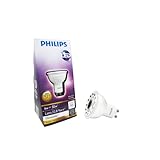
List Price: $31.47
Sale Price: $29.97
Today's Bonus: 5% Off

This bulb is 120 Volts, not 12 Volts. This is an important distinction. Luckily, GU10 bases (round posts at the bottom of the bulb) are always base voltages (120V) and were specifically designed to prevent people from using them in low voltage application. As a result, there is no way you can use it in a 12V circuit. The Philips website also confirms this bulb is 120V, not 12V. Interestingly, the box itself doesn't specify the voltage, but GU10 are always 120V not 12V.
Note that MR16 describes the shape of the bulb at the top. MR stands for multifaceted reflector, and the 16 is for how many eighths of an inch at the top of the bulb, therefore 16 eighths, which equals 2 inches. The GU10 part refers to the base of the bulb. GU10 are spaced by 10mm and always used for base voltages (120VAC in the US), so no transformer is required. A 12V MR16 will not have GU10 connector and will simply be called MR16 or MR16 GU5.3 bi-pin standard. The GU5.3 part is often omitted since it is the standard. However, if the bulb is specified to be MR16 GU10 (as this one), it will always be 120V.
Amazon needs to correct the product title and description.
Click Here For Most Helpful Customer Reviews >>
I'm comparing the Philips 6W GU10 #822882 from HD and Feit 6.5W GU10 and used 50W GU10 Halogens that came with my 12-year old house remodel. I used a Nikon D4 digital camera, WhiBal color reference card, Lightroom 4.3, and a Sekonic L-358 light meter. FWIW, I do not have a dimming wall switch yet.Light color:
Feit 6.5W: 2950 kelvin
Philips 6W: 2950
Halogen 50W: 2600
Intensity, measured @ 1 meter distance:
Feit 6.5W: 7.3 EV (x 2.5 for lumens?)
Philips 6W: 7.5 EV
Halogen 50W: 7.3 EV
Size:
Feit 6.5W: 50.4mm L x 50.0mm rim x 46.25mm bowl
Philips 6W: 48.25mm L x 50.0mm rim x 45.85mm bowl
Halogen 50W: 46.25mm L x 49.9mm rim x 46.50mm bowl
Observations:
Feit 6.5W: Has four LED's positioned close to the front glass element, causing significant glare when observed near the side. Guess the power-on delay is 1/2 second. Will not fit into the tulip bowel of my track lighting fixture without performing surgery on the fixture due to the extended large diameter of the bulb's "bowl".
Philips 6W: Has one LED positioned back in a bowl reflector, so there is less side glare than the Feit, but significantly more than the Halogen. Instant power-up and fits in the fixture the same as the older halogen.
Halogen 50W: These have best positioned light element, furthest back from the front glass to minimize side glare. Also these spill light out the back, which give an aesthetic lighting glow to the light fixture. The backside of the LED bulbs are completely dark.
I decided to go with the Philips, but help me out... I'd like to cobble up a couple of tiny LEDs that sits on the back bowl of the lamp, connected with thin leads to the 120VAC posts of the GU10 fitting... bringing back the aesthetic back-spill light. Got suggestions for me on how to rig this up?
Also note that I do not have more that a few hours user experience with these bulbs, my star rating might change if these see an early death.
Feit Electric MR16/GU10/DM/LED 5 Watt, High Performance Dimmable MR16 Bi-Pin Bulb
Best Deals for Philips 423418 6-Watt (50-Watt) MR16 LED Indoor Flood GU10
We have a track light over our dining room table which incorporates six 50w GU10 bulbs. Although probably not used enough to justify the cost of these bulbs on energy savings, the halogens do create quite a bit of heat. After sitting at the table for a while, one can definitely feel it. So in this case I switched to LEDs simply to increase the comfort of the room while dining.Prior to Philips making these bulbs available, I had bought one Ecosmart/LSC 6w LED GU10 at a 'big orange box store' to test out. It is about less expensive than the Philips and emits about the same amount of light. But the Philips is the better bulb for a couple of reasons.
Sizewise, both the Philips and the LSC are almost exactly the same size as the halogen. I did not have any fitment problems.
Lightwise, both LED bulbs are slightly 'whiter' than the halogens. A previous reviewer measured this, and confirms my observations. And yes, the single recessed LED in the Philips is definitely an advantage over the multiple nearly surface mounted LEDs in the LSC bulb. Less glare in the Philips.
I did some measurements using a 'light meter' app on my smart phone laying the phone on the table under the lights. Light levels are actually a bit higher with the Philips bulbs than with the halogens.
One area where the Philips really shines, so to speak, is its dimmability. With a (non-LED specific) Lutron Diva dimmer, the Philips bulb does an outstanding job of dimming. It can dim down to near nothing. The LSC GU10 flickers and only dims slightly. (In fairness, the LSC is not advertised as a dimmable bulb.) One can occasionally see some flicker from the Philips but usually a slight adjustment of the dimmer can take it out. Worst comes to worst, just reinstall one of your halogens. It would be interesting to know if a Lutron C-L series dimmer would take care of the issue.
If dimmability wasn't a requirement for me, I would probably have simply bought more of the LSC bulbs and tried to ignore the extra glare. But the Philips are so much better at dimming that they were worth the extra cost to me.


0 comments:
Post a Comment